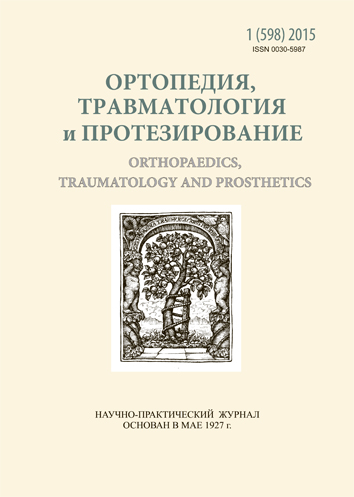The method of fixation of the ulnar nerve after its subcutaneous transposition
DOI:
https://doi.org/10.15674/0030-59872015179-82Keywords:
subcutaneous transposition, fixation of the ulnar nerve, skin-subcutaneous-fascial block-scarAbstract
For prevention of dislocation of the ulnar nerve after its subcutaneous transposition they use various methods: fixation of the nerve with cut in a special way fascial or adiposal patches-blocks. The paper presents one more way to solve this problem. Objective: To describe the method of fixation of the ulnar nerve after its subcutaneous transposition. The method is simpler and less traumatic compared with other ones. Methods: subcutaneous transposition of the ulnar nerve we performed in 8 patients with idiopathic syndrome of cubital channel and in 3 with inveterate injury of the ulnar nerve. For approach to the ulnar nerve in the area of elbow joint they perform longitudinal undulating incision with length of 12–14 cm. The top of one of the «waves» section should be turned laterally and placed 1.5–2 cm laterally from the apex of the medial epicondyle of the humerus. After transposition of the nerve in the forearm fascia in the longitudinal direction they perform C-shaped incision that form and location coincides with the peak of the «wave» of skin incision. In the area of the top «wave» they impose 3–4 vertical mattress skin and subcutaneous fascial sutures. Postoperative immobilization is not used except stitching of damaged nerve when they impose splint in flexion position of the forearm. Transpositioned nerve is held in place due to skin-subcutaneous-fascial scar created. The outcomes were assessed in 10 patients after 13 months in average (from 3 to 24) after surgery. In none patients during active-passive flexion-extension of elbow there were not determined any dislocation of the fixed ulnar nerve in the area of the ulnar groove. Full function in elbow was preserved in all of 10 patients. There was no observed any phenomena of irritation of displaced ulnar nerve by postoperative scar. The positive outcomes were obtained in all cases. Conclusions: The described by us simple and low-impact method is effective and can be successfully used to fix the ulnar nerve after itssubcutaneous transposition.
References
- Caputo A. E. Subcutaneous anterior transposition of the ulnar nerve for failed decompression of cubital tunnel syndrome / A. E. Caputo, H. K. Watson // J. Hand Surg. — 2000. — Vol. 25-A (3). — P. 544–551.
- Catalano L. W. Anterior subcutaneous transposition of the ulnar nerve / L. W. Catalano, O. A. Barron // Hand Clin. — 2007. — Vol. 23 (3). — P. 339–344.
- Jaddue D. A. K. Subcutaneous vs submuscular ulnar nerve trans¬position in moderate cubital tunnel syndrome / D. A. K. Jaddue, S. A. Saloo, A. S. Sayed-Noor // Open Orthop. J. — 2009. — Vol. 3. — P. 78–82. doi: 10.2174/1874325000903010078.
- Palmer B. A. Cubital tunnel syndrome / B. A. Palmer, T. B. Hughes // J. Hand Surg. — 2010. — Vol. 35-A (1). — P. 153–163. doi: 10.1016/j.jhsa.2009.11.004.
- Posner M. A. Compressive neuropathy of the ulnar nerve at the elbow / M. A. Posner // Peripheral nerve surgery: practical application / D. J. Slutsky, V. R. Hentz [eds.] — 1st ed. — Philadelphia: Churchill Livingstone, 2006. — P. 256–268.
- Ruchelsman D. E. Failed surgery for ulnar nerve compression at the elbow / D. E. Ruchelsman, S. K. Lee, M. A. Posner // Hand Clin. — 2007. — Vol. 23 (3). — P. 359–371.
- Subcutaneous anterior transposition for treatment of cubital tunnel syndrome: is this method safe and effective? / S. Lima, J. F. Correia, R. M. Martins [et al.] // Rev. Bras. Ortop. — 2012. — Vol. 47 (6). — P. 748–753. http://dx.doi.org/10.1590/S0102-36162012000600013.
- Ulnar nerve transposition using a mini-invasive approach: case series of 30 patients / T. Lequint, K. Naito, T. Awada [et al.] // J. Hand Surg Eur Vol. — 2013. — Vol. 38 (5). — P. 468–473. doi: 10.1177/1753193412456927.
- Ulnar nerve dislocation at the elbow: review of the literature and report of three cases / K. C. Xarchas, I. Psillakis, O. Kouk¬ou [et al.] // Open Orthop. J. — 2007. — Vol. 1. — P. 1–3. doi: 10.2174/1874325000701010001.
Downloads
How to Cite
Issue
Section
License
Copyright (c) 2015 Sergey Goloborod'ko

This work is licensed under a Creative Commons Attribution 4.0 International License.
The authors retain the right of authorship of their manuscript and pass the journal the right of the first publication of this article, which automatically become available from the date of publication under the terms of Creative Commons Attribution License, which allows others to freely distribute the published manuscript with mandatory linking to authors of the original research and the first publication of this one in this journal.
Authors have the right to enter into a separate supplemental agreement on the additional non-exclusive distribution of manuscript in the form in which it was published by the journal (i.e. to put work in electronic storage of an institution or publish as a part of the book) while maintaining the reference to the first publication of the manuscript in this journal.
The editorial policy of the journal allows authors and encourages manuscript accommodation online (i.e. in storage of an institution or on the personal websites) as before submission of the manuscript to the editorial office, and during its editorial processing because it contributes to productive scientific discussion and positively affects the efficiency and dynamics of the published manuscript citation (see The Effect of Open Access).














